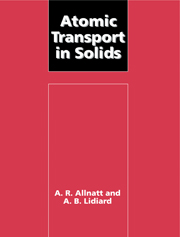Book contents
- Frontmatter
- Contents
- Preface
- List of principal symbols
- 1 Atomic movements in solids – phenomenological equations
- 2 Imperfections in solids
- 3 Statistical thermodynamics of crystals containing point defects
- 4 Non-equilibrium thermodynamics of atomic transport processes in solids
- 5 Some applications of non-equilibrium thermodynamics to solids
- 6 Microscopic theories – the master equation
- 7 Kinetic theory of relaxation processes
- 8 Kinetic theory of isothermal diffusion processes
- 9 The theory of random walks
- 10 Random-walk theories of atomic diffusion
- 11 Transport coefficients of dilute solid solutions – results and applications
- 12 The evaluation of nuclear magnetic relaxation rates
- 13 Theories of concentrated and highly defective systems
- References
- Index
13 - Theories of concentrated and highly defective systems
Published online by Cambridge University Press: 28 December 2009
- Frontmatter
- Contents
- Preface
- List of principal symbols
- 1 Atomic movements in solids – phenomenological equations
- 2 Imperfections in solids
- 3 Statistical thermodynamics of crystals containing point defects
- 4 Non-equilibrium thermodynamics of atomic transport processes in solids
- 5 Some applications of non-equilibrium thermodynamics to solids
- 6 Microscopic theories – the master equation
- 7 Kinetic theory of relaxation processes
- 8 Kinetic theory of isothermal diffusion processes
- 9 The theory of random walks
- 10 Random-walk theories of atomic diffusion
- 11 Transport coefficients of dilute solid solutions – results and applications
- 12 The evaluation of nuclear magnetic relaxation rates
- 13 Theories of concentrated and highly defective systems
- References
- Index
Summary
Introduction
In the preceding Chapters 6–12 we have dealt with the general structure of the various statistical theories of atomic transport in solids and with the relations between them. However, in obtaining analytical results for specific classes of model the emphasis has been mostly on dilute alloys and solid solutions containing only low concentrations of defects. The theory of such systems is made easier because we need to retain only the lower-order terms in defect and solute concentrations. In this chapter we turn to theories of so-called lattice-gas models which give physically simplified representations of both concentrated alloys and systems containing high concentrations of defects. In such systems the concentrations of the components are not useful expansion parameters. As a result, and as is usual in statistical mechanics, an accurate theory is much more difficult to formulate in these circumstances.
The rather broad range of systems of current interest includes (i) ideal or random alloys and solid solutions (such as were discussed in §§5.6 and 10.8), (ii) alloys displaying short-range or long-range order and (iii) various systems where the number of mobile atoms is significantly less than the number of sites available to them. In this third group these sites are commonly interstitial sites within a structure formed by relatively immobile atoms. Examples are provided by the β-aluminas and other fast ion conductors (Laskar and Chandra, 1989), metals containing interstitial hydrogen or deuterium atoms and various other interstitial solid solutions (e.g. the tungsten ‘bronzes’; Cox, 1992). We shall refer to the sublattice of interstitial sites in these systems simply as the lattice.
- Type
- Chapter
- Information
- Atomic Transport in Solids , pp. 505 - 552Publisher: Cambridge University PressPrint publication year: 1993

